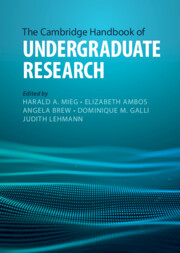Book contents
- The Cambridge Handbook of Undergraduate Research
- The Cambridge Handbook of Undergraduate Research
- Copyright page
- Contents
- Figures
- Tables
- Contributors
- Foreword
- Foreword
- 1 Introduction
- Part I Theory and Research on Undergraduate Research
- Part II Implementation, Approaches, Methods
- Part III Disciplines
- 17 Introduction
- Part III.1 STEM
- Part III.2 Health
- 24 Undergraduate Research in Medicine
- 25 Undergraduate Research in Health Sciences
- 26 Undergraduate Research in Nursing
- 27 Undergraduate Research in the Exercise Science Discipline
- Part III.3 Social Sciences
- Part III.4 Humanities
- Part III.5 Arts & Design
- Part III.6 Disciplines A–Z
- Part IV International Perspective
- Part V Avenues for Developing Undergraduate Research
- Index
- References
26 - Undergraduate Research in Nursing
from Part III.2 - Health
Published online by Cambridge University Press: 11 August 2022
- The Cambridge Handbook of Undergraduate Research
- The Cambridge Handbook of Undergraduate Research
- Copyright page
- Contents
- Figures
- Tables
- Contributors
- Foreword
- Foreword
- 1 Introduction
- Part I Theory and Research on Undergraduate Research
- Part II Implementation, Approaches, Methods
- Part III Disciplines
- 17 Introduction
- Part III.1 STEM
- Part III.2 Health
- 24 Undergraduate Research in Medicine
- 25 Undergraduate Research in Health Sciences
- 26 Undergraduate Research in Nursing
- 27 Undergraduate Research in the Exercise Science Discipline
- Part III.3 Social Sciences
- Part III.4 Humanities
- Part III.5 Arts & Design
- Part III.6 Disciplines A–Z
- Part IV International Perspective
- Part V Avenues for Developing Undergraduate Research
- Index
- References
Summary
Undergraduate research in nursing has demonstrated effectiveness in producing emerging scholars and leaders for the profession by nurturing the spirit of inquiry, creativity, and collaboration needed to advance the profession. Undergraduate research in nursing opens a window of creativity, mentoring, longitudinal relationships, and inspiration for the bright and gifted students entering the profession. The diverse nature of nursing provides a broad spectrum of transformative research opportunities for nursing students to establish scholarly identity at the launch of their careers. These range from diverse curricular models, clinical research internships, service-learning/global initiatives, faculty-led studies, and interprofessional research collaboration. Nursing theories guide research projects grounded in the discipline. Visionary leadership with adequate resources and a strategic approach to undergraduate research mentoring yield mutually beneficially outcomes in the process of developing requisite skills for graduate studies. Nursing education transformation that fosters a research culture contributes to a bright future with a vision of global significance.
Keywords
- Type
- Chapter
- Information
- The Cambridge Handbook of Undergraduate Research , pp. 258 - 266Publisher: Cambridge University PressPrint publication year: 2022



